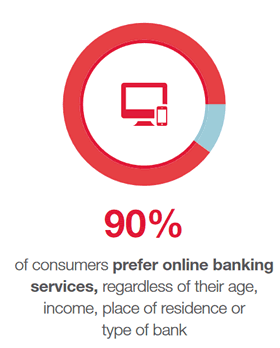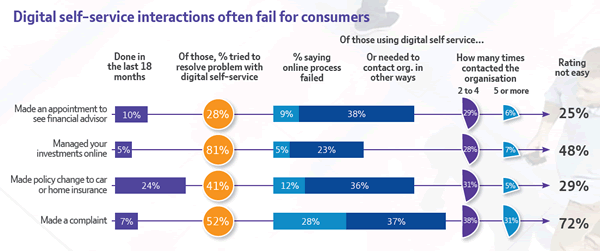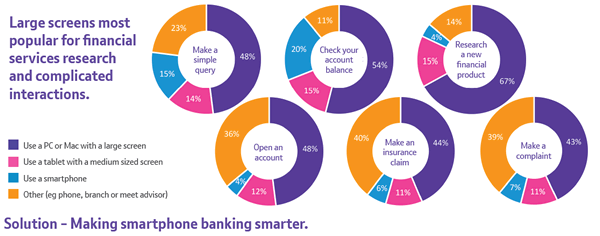Digital banking and mobile banking are mainstream, yet research shows that not all is well from the consumer perspective.
What do customers expect from their banks? In order to know it’s always good to conduct some (VoC) research and analyze the individual sitation as all banks are different and contextual (e.g. geographical) factors apply.
However, there is a load of research looking at that question regarding banking customer expectations in more generic ways, globally and locally. The most often mentioned expectations that are known since quite a few years now are digital and mobile banking possibilities, essentially where stage one of most digital transformation in banking has happened. Yet, despite that clear demand and these investments, we are certainly not there yet.
Digital banking: cool and hip don’t cut it
The importance of digital and mobile channels for bank customers isn’t new, it just keeps growing, accelerating and also changing.
Despite the fact that omni-channel banking expectations, driven by digital and mobile (or mobility) demands of a channel-agnostic consumer are not new and well documented, reality shows that banks still have a lot of work in regards with digital and mobile offerings. There is a reason why fintech is being increasingly embraced and even banks who did efforts in the omni-channel digital space realize that not all is what it should be.
Often front-end applications look a bit like lipstick on a pig and an increasing number of reports indicates that digitization and digital transformation efforts are not leading to desired outcomes, leaving retail/consumer bank customers dissatisfied and making them need banks’ help with the offered mobile and digital solutions.
To mention a quote used in a new report from the Massachusetts Institute of Technology (MIT) which looks into the future potential of digital banking and is entitled “Digital Banking Manifesto: The End of Banks?” (PDF opens): “Banks are trying to be cool and hip and build super cool digital front ends… But it’s like putting lipstick on a pig – ultimately it’s still a pig and the new front end is still running into an awful digital back end.”
There’s the lipstick and pig again. The truth is that everyone knows it since many years but let’s face it: it’s still the case.
The appetite for omni-channel banking keeps growing
At the same time the customer’s hunger for digital and mobile interaction, service and banking services possibilities won’t stop growing. This doesn’t mean the physical branch is dead nor that the distance between banks (and many other financial services providers) is increasing.
It’s mainly a matter of choice (hence omni-channel) and a desire for being able to engage with banks when, where and how the customer wants it. And, regarding that distance: with mobile applications and digital tools at disposal one can say that customers are closer to their banks than ever before: they even carry them around in their pockets, imagine.
We’ve tackled the growing importance of direct and digital channels (also for banks’ acquisition and marketing efforts) in retail/consumer banking before, with data for the US, Europe, the Middle East and across the globe. It’s important to mention that, as Nielsen found and as we mentioned in that previous overview, customers have preferences per banking channels, depending on the type of financial activity/task. Customer demands regarding the ease, quality and experiences of digital and mobile possibilities also exactly aren’t a surprise. People just want the same ease of use, choice and digital/mobile enablement and experiences as they are used to get in other industries.
Today’s digital banking customer is not tomorrow’s
The rising adoption of fintech by customers certainly also is related with the fact that many banks, the laggards, have waited too long to respond to these needs. This is certainly the case for specific user segments. If you look at the early adopters of fintech providers’ services and the most demanding customers on a digital and mobile level, you’ll notice the overlap.
It’s the second time I mention fintech and for a reason. While, as we’ll see further, consumers want more support possibilities and choices regarding digital services for all the good (“I feel uncomfortable regarding an important task and expect some form of help, also digitally”) and all the bad (“it doesn’t work or is too hard and I don’t find my way”) reasons, there is not a doubt that best-in-class online players in any given industry and also the best fintechs will raise the bar further and the consumers of tomorrow will be more savvy and demanding. Well, they are already. Here is a quote from a McKinsey article I found very relevant: “Banks must recognize that customer expectations are increasingly being set by nonbanks”.
Indeed. And here is a second quote that is equally relevant: “The proliferation of mobile devices and shifting preferences among demographic groups mean that customers expect more real-time, cross-channel capabilities (such as status inquiries and problem resolution) than ever before”. And this won’t stop anytime soon.
I’m not a big fan of generational generalizations but facts are facts. And, if we can believe 2016 BAI research (US) as another example, “for Millennials, mobile use will rise to 34.3% from 26% while GenXers will turn to mobile for 27.5% of their banking activity, up from 20.4%”.
Digital banking is a growing reality but do we meet customer demands properly?
So, although digital and mobile banking services are what most customers want, it’s worth to keep repeating it as some banks and regions still have to catch up and not all is good in digital banking land – from the customer’s perspective.

Just another number stressing once more that consumers do want online services: according to CGI’s report, entitled “Financial Consumer Demands for Tomorrow’s Digital Bank“, 90 percent of consumers prefer online banking services and this regardless of age, income, place of residence or type of bank (10 percent of consumers said they didn’t use their bank’s online services unless they have to). The research was conducted by Research Now in the US, Canada, the UK, France, Germany, Sweden and Australia (OK, online and digital and mobile are not entirely the same but we have more stats and wanted to make a point).
Responding consumers also predict the advent of a highly digital banking environment. 37 percent expect all banking to be done digitally. 36 percent expect all banking to be done through smartphones. 30 percent expects that banking will be using fingerprint recognition technology.
And yes, some respondents are looking closely at those disruptive newcomers called fintechs, who are all about digital, according to CGI (PDF opens) too.
Time to look at that question to what degree we meet online/digital/mobile banking demands.
Basic banking interactions have been automated but silos, isolated efforts and lacking information remain a challenge
Another report which has been looking into consumer expectations and attitudes in regards with digital banking is “Youbiquity Finance”. Launched in 2012, the research by Davies Hickman Partners is conducted across Germany, Spain and the UK, on behalf of Avaya and BT (a partner).
In the 2016 edition of “Youbiquity Finance”, the fact that digital and mobile banking need more work from a customer perspective, becomes clear. As the report says many basic banking interactions such as account balance enquiries and payments have been automated and smartphone apps have made these tasks easier.
However, there is a range of banking interactions which have been digitized but will require human support if banks want them to be successfully used by customers. The report mentions several areas where this is needed and we highlight a few.
What we de facto see is that there are still quite some ad hoc and isolated efforts and that digital transformation isn’t approached from a holistic perspective enough, leaving various processes, back-office operations and crucial information sources out of the equation with the mentioned overemphasis on front-end apps.
Overall customer experience optimization has improved – digital, mobile and online need more attention and support
Of course not all is bad. As the infographic of the research shows, there is for example a 74 percent increase in UK customers saying that their bank puts customers at the hart of their business.
Moreover, if we look at the World Retail Banking Report 2016‘s Customer Experience Index, customers in over 85 percent of countries reported improved banking experiences. And that after a year, 2015, where it stagnated. So that seems like good news.
Obviously overall customer experience is a big thing and you also need to look at financial processes that are digitized and enabled via mobile which are essential for your omni-channel consumer. And it’s, among others here, that we see more and more alarm signs: from the ease of use and user experience perspective, as well as from the lack of information, good processes, integration and support that is required to make it all work for the consumer. It reminds me of the words of Gerry McGovern in an interview: ease of use is a tsunami ripping across the world.
On the process integration level it’s also a bit as The Financial Brand says in a post promoting its “State of the Digital Customer Journey” report: “The vast majority of financial institutions surveyed do not offer a consistent digitalization of any given process, with many engagements that begin on a digital channel requiring either a manual or in-person interaction to complete”.
Back to those findings of the “Youbiqity Finance 2016” report to illustrate with some examples. The report states that digital self-service interactions often fail for customers, from basic interactions such as making an appointment to see a financial advisor or making a compliant to managing investments online and making policy changes to insurances.
From missing information to hard and slow processes – even when they are crucial for the bank
The analysis showed that one on two or more customers rated complaint-handling and managing investments online as “not easy”. In other words: as hard. If making a complaint is hard you can imagine the impact on the complaint in a world where people want ‘easy’, not ‘hard’, exactly what digital promises to do.

Another staggering observation: when wanting to make an appointment to see a financial advisor (which screams “business ahead”) 6 percent of respondents using digital self-service tools to do so had to contact an organization more than five (yes, 5!) times.
And it doesn’t stop there: information to apply for something is often missing so the application can’t be done, online processes are hard to find or too complicated or too long, the list goes on.
The online banking challenge: your customers need too much human help
It all has led to a rather remarkable, yet in some conditions where the stakes are high from the consumers perspective understandable, phenomenon: respondents want help from a real person, especially when something goes wrong and guidance or reassurance is needed.
As such that’s not a disaster but you can imagine the negative consequences on various levels. Making sure that information is available, connecting faster with back-end processes and simply making online and digital tools easier to use reduces the need for human help, which is expensive, certainly for simple actions such as filing a complaint or asking an appointment!
Mobile banking: work ahead
A second finding from the research we want to briefly touch upon is that mobile banking needs better functionality to grow. It’s simple: far more consumers are using mobile (smartphone) banking appps but in some areas adoption growth seems to slow and apps underperform.
Obviously, not everything is easy to do via mobile but it’s key to get the essence in order and there is certainly room for improvement. The conclusion of the report: make smartphone banking smarter (and better and easier). For financial services research and complicated interactions, large screens tend to be more popular as the image from the report below shows.

All in all, many opportunities remain but there are also many challenges. Mobile banking, online banking, consumers want it but they don’t always get what they want and if they do all too often interactions are broken or information is missing.
There’s something organizations can do about that: it’s called being more holistic, integrated, connected and looking at all processes and resources needed, with a clear focus on information, experiences, connecting the dots and not overlooking the back end.
Getting the first stage of digital banking right: time to act (as stage two is urgent)
With all the challenges and technological evolutions going on here is a concluding thought. We quote from an April 2016 McKinsey article: “The digital revolution in banking has only just begun. Today we are in phase one, where most traditional banks offer their customers high-quality web and mobile sites/apps”.
Well, if you want to move to stage two in constructing a house you need to make sure that stage one, the foundations, are right. It isn’t any different in building a true digital bank. And certainly not all banks seems to offer the high-quality web and mobile sites/apps as we’d expect. The challenges and consequences are known.
Disclaimer: this entry is not sponsored by any of the mentioned companies. Top image: Shutterstock – Copyright: everything possible – All other images are the property of their respective mentioned owners.


